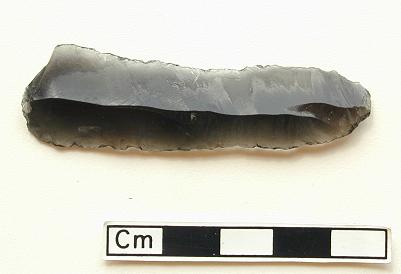Chipped Stone
Tristan CarterThis years focus was to study for publication the chipped stone from the North and South areas, plus the material from the 1999 KOPAL trench. Preparatory work commenced in Cambridge in May, where significant progress was made in analysing existing data. The field study concentrated on characterizing chosen assemblages, with regard to their typological and technological characteristics, plus an attempt at understanding life-histories and taphonomy, through refitting and use-wear analysis. Over 500 drawings were made for the final publication.
The study has clearly shown that more than one obsidian industry existed, in parallel, from the basal levels upwards. Indeed, such complexity seems to be a common theme at Çatalhöyük, though the products themselves changed over time. The earliest two levels, [Pre-Level XII/(C-D)], produced a quantity of pieces with direct parallels from the aceramic site of Aşıklı Höyük in Cappadocia, though this material is always in the minority and has no associated manufacturing debris. The early levels are also notable for the wide range of non-obsidian raw materials, with a variety of limno-quartzites, radiolarite and chert. Another feature is the number of projectiles with use-wear and the quantity of sickles, a tool-type virtually unknown from later deposits. Other notable discoveries included two points with incised decoration from Pre-Level XII contexts, the first examples known from Çatalhöyük and only the second time that such pieces have been found outside Can Hassan III.

Figure 14: Obsidian blade from the West Mound
Obsidian Sourcing
An exciting new component of our work at Çatalhöyük is a large project of obsidian sourcing. The study aims to investigate the history of obsidian exploitation through time (by household) and to examine whether the variant industries represented at the site relate to different raw materials. For this reason, all of the obsidian chosen for analysis has been drawn for publication alongside the results. The project is multinational, involving a number of laboratories and more than one analytical technique. The initial work is being undertaken on 150 samples by the Groupe de Géophysique Nucléaire, CNRS-Université Joseph Fourier, Grenoble, France and at Middle Eastern Technical University (METU), Ankara Turkey, using Inductively Coupled Plasma - Mass Spectroscopy (ICP-MS). A further 40 pieces of obsidian are being analysed in a pilot study at the University of Aberystwyth, Wales, using Laser Ablation ICP-MS, a non-destructive technique.
The samples have been taken from good archaeological contexts, from both the East and West Mound, spanning Neolithic Levels X-V, and the Chalcolithic. Initial results from Grenoble indicate that the Cappadocian sources of Göllü Dağ-east and Nenezi Dağ are the primary sources of Çatalhöyüks obsidian. The results also suggest that there may be significant differences in the history of these obsidians exploitation: chronologically, technologically and contextually.